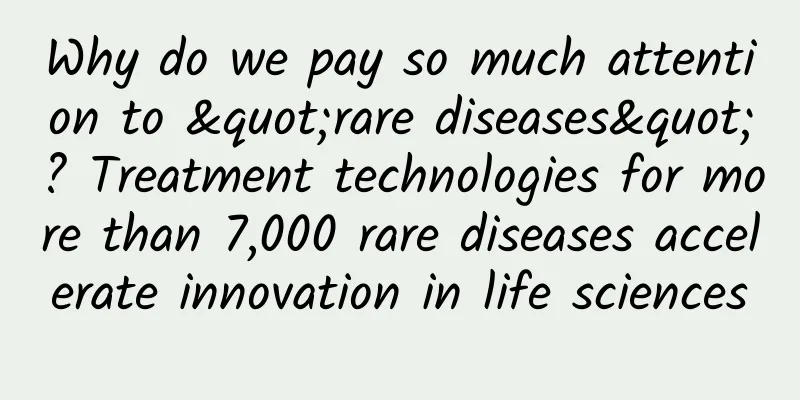Why do we pay so much attention to "rare diseases"? Treatment technologies for more than 7,000 rare diseases accelerate innovation in life sciences

|
Introduction According to statistics, there are more than 7,000 rare diseases known to humans, but less than 10% of them have corresponding treatment plans. The vast majority of rare diseases are difficult and complicated, and many patients face the dilemma of having no medicine to treat them. In order to better understand rare diseases, today we will interview Professor Wang Zhichao, deputy chief physician of the Ninth People's Hospital affiliated to Shanghai Jiao Tong University School of Medicine. What is a rare disease? Q: There are about 20 million people suffering from rare diseases in China, so it can be said that rare diseases are not rare. So how is a rare disease defined in medicine? Wang Zhichao: In fact, the medical community defines rare diseases based on incidence. There are differences in definitions in different countries, regions and around the world. Rare diseases usually refer to those with low incidence and concentrated in a small number of people. The World Health Organization (WHO) defines rare diseases as "an incidence rate of less than 1/1500". Since the United States has relatively sufficient medical resources, it defines rare diseases as "only one disease in every 1,000 newborns". However, my country has not yet set a clear definition for rare diseases. Different countries have different definition standards for the total number of patients. For example, some countries define rare diseases as those with a total number of patients less than 100,000, 300,000 or 500,000. Globally, many countries may combine the World Health Organization's standards, i.e., an incidence rate of 1/1500, and consider the accessibility, adequacy, medical level and overall level of population health development of medical resources to establish the definition of rare diseases, so as to provide better services for patients with rare diseases. With the continuous advancement of medical technology, the improvement of the medical environment, the improvement of society, and the continuous emphasis on individual values, the rare disease group has received more and more attention and support. What are the common rare diseases? Q: What are the common rare diseases? Wang Zhichao: Rare diseases are usually named based on the systems, organs, symptoms they affect, and specific deficient substances. Although the naming methods vary, they basically cover key tissues and organs of the human body. For example, amyotrophic lateral sclerosis (ALS) is one of the more common rare diseases. Other common rare diseases include neurofibromatosis, congenital giant nevus (hairy children), unique types of hemophilia, Duchenne muscular dystrophy, etc. Of course, there are many rare diseases that we are not familiar with or even have no name. Although the number of people with these diseases may be small, their symptoms may be more serious. In general, there are more than 7,000 different rare diseases, each with its own specific patient population. Although these diseases are all called rare diseases, their symptoms and manifestations vary greatly. Due to the limited number of these diseases and the low incidence rate, they are collectively referred to as rare diseases. Neurofibroma Duchenne muscular dystrophy Why focus on rare diseases? Q: In the past two years, many people have been discussing the topic of rare diseases. Why do we pay attention to rare diseases? What is the general situation of rare disease groups in my country? Wang Zhichao: I once read a report that explored the impact of rare diseases on individual patients and their entire families. This impact is not limited to the patients themselves, but also affects their families. When taking into account patients with various rare diseases and their families, it can be found that one out of every 10-20 people in the entire society is affected by rare diseases themselves or relatives of rare disease patients. Therefore, the burden imposed on society by the entire rare disease group is very heavy. So why is the current society paying more and more attention to rare diseases? First, with the continuous advancement of medical technology, many common diseases can be effectively controlled; second, the status of humanistic care in the whole society is increasing, and we realize that no minority group should be ignored, and we should help those who have not benefited from the development of science and technology and biology for a long time; third, many breakthroughs in the treatment of rare diseases can also have a positive impact on the treatment of common diseases. As one expert said, rare diseases, as a starting point for research, can actually benefit patients with a wider range of common diseases. Therefore, we provide some medical development ideas from different angles and continue to provide care for medical service recipients and the entire social population. Factors affecting rare diseases Q: What are the main causes of rare diseases? Wang Zhichao: The causes of rare diseases involve multiple factors, among which genetic factors are the most important. In addition, environmental factors and the interaction between environment and genes can also lead to the occurrence of rare diseases. The genetic penetrance of neurofibromatosis type I that we studied reached 100%. In other words, all patients carrying adverse genes will show clinical symptoms of rare diseases. However, not all diseases have 100% penetrance. Some diseases may require specific environmental factors to stimulate their symptoms. In this case, the onset of rare diseases may be determined by the combined effects of genes and the environment. Q: Can you tell us about other factors that may affect rare diseases, such as the environment? Wang Zhichao: A typical example is pneumoconiosis. Although its incidence rate is not high at present, the fibrosis it causes in the lungs and its severity may also belong to the category of rare diseases. In addition, environmental factors can also affect the occurrence of rare diseases. One of these diseases is caused by a special infection, such as Kaposi's sarcoma, which occurs in patients with severely impaired immune systems. Such severe patients need long-term chemotherapy and immunosuppressive therapy, or may be accompanied by bone marrow suppression of the blood system, or even HIV infection, which will cause them to suffer from secondary rare diseases. Therefore, environmental factors play an important role in the pathogenesis of such rare diseases. In addition to drugs, what other treatments are there for rare diseases ? Q: In addition to drug treatment, many rare diseases are treated through surgery. Can you introduce the current progress in this area? Wang Zhichao: The main treatment for neurofibromatosis is surgery. When drugs cannot effectively control the disease, we will use surgery. However, neurofibromas, which grow on nerves, may face some problems with traditional surgical methods. First, it may cause nerve damage; second, the patient may also experience some damage after surgery. With the advancement of modern surgical technology, we can take some measures to solve these problems: First, through real-time nerve monitoring during surgery, we can maximize the preservation of normal nerve function while ensuring tumor resection. This approach can minimize potential nerve damage while also ensuring adequate coverage of the resection range, finding a good balance. Second, we can use intraoperative nerve development technology, which can more accurately distinguish tumors from normal nerves during the dissection process, so that we can "know what is going on and not panic." Third, in the process of neurofibroma development, in addition to the growth of the tumor itself, it will also cause secondary changes in surrounding organs. For example, facial plexiform neurofibromas or secondary compression caused by neurofibromas may lead to facial bone abnormalities. By applying 3D scanning and 3D printing technology, we can simulate the scope of the tumor in advance, design the scope of bone defects after surgery, and provide a precise plan for the patient's appearance reconstruction. These methods are the epitome of surgical treatment and technological progress in the field of rare disease treatment. Rare diseases and the application of new technologies Q: The field of rare diseases is often a testing ground for many new technologies. In the past two years, gene editing technology has developed rapidly and has been applied in rare diseases such as hemophilia, amaurosis, and Duchenne muscular dystrophy. In addition to gene editing, what other new medical technologies have new applications in the field of rare diseases, such as mRNA technology and protein degradation technology? Wang Zhichao: Taking gene editing as an example, neurofibromatosis is caused by NF1 gene mutation, and its pathogenic gene is also very clear. However, why has gene editing technology not yet been widely promoted in the field of rare diseases? First, although the mutated gene has been clearly located, the mutation site is different for each patient. Therefore, it is very expensive to customize the treatment plan for each patient. Unlike the case where a protein is missing and then supplemented by a gene vector, this method cannot be applied to all patients, especially in cases such as neurofibromatosis, where the missing protein is different, making treatment very difficult. Second, the neurofibromatosis gene encodes a neurofibromatosis protein that is extremely large, exceeding the upper limit of the gene fragment that can be accommodated by all current gene therapy vectors. Third, the vectors currently used for nervous system gene therapy, including adenovirus and lentivirus, have not yet achieved efficient transfection efficiency. Therefore, all three aspects require further technological breakthroughs. In addition, gene therapy, as an emerging treatment concept, is still in its early stages. With the continuous improvement of technology and vectors, as well as the development of gene therapy models, more diseases may benefit from it. In addition to gene therapy, immunotherapy, cell therapy, etc. are also the future directions for the treatment of rare diseases. However, which direction is suitable for which rare disease needs to be determined based on the intervention model related to the pathogenesis of the disease. Only in this way can we better adapt to the characteristics of the disease. Therefore, rare diseases require “specific analysis of specific issues”. Currently, there is no one-size-fits-all approach. Only after systematic analysis of every patient, every type and subtype of the disease can we find a suitable method to better enable patients to benefit from the development of new technologies. The link between rare and common diseases Q: Song Baoliang, an academician of the Chinese Academy of Sciences, once said, "Research on rare diseases helps us understand common diseases." What do you think about this? Wang Zhichao: I agree with this view very much. As we often say, “rare diseases are the entrance and common diseases are the exit”. As a special group, patients with rare diseases provide us with a unique perspective to understand the treatment, diagnosis and development mechanism of the disease. However, the new therapies, new drugs and new treatment methods developed from this perspective are not only applicable to a single rare disease group, but also have a wider applicability and can serve a wider range of people. As we all know, gene therapy has made breakthroughs in rare diseases, but its scope of application is not limited to rare diseases. Instead, it shows a broader application prospect in the treatment of various diseases. Our in-depth research on rare diseases not only helps to deepen our understanding and cognition of common diseases, but also lays the foundation for the application of some new therapies, which are often initially applied in the field of rare diseases. Rare disease research and cutting-edge technology innovation Q: A top medical school in China is building an innovation base for the research of difficult and rare diseases and cutting-edge technologies. What is the connection between the research of rare diseases and cutting-edge technological innovation? Wang Zhichao: First, the number of patients with rare diseases is relatively small, and they are usually "difficult and complicated diseases" in medicine. Therefore, the medical community needs to concentrate its superior resources and use targeted methods to break through the treatment difficulties of these rare diseases. Since traditional treatments may not be effective in some rare disease cases, special research and innovation are needed. Second, since rare diseases often lack effective treatments, the country and the patient population are in urgent need of an innovative and unconventional treatment method to bring hope of treatment to this special group. On a practical level, with the continuous increase in investment, patients with rare diseases may usher in a new dawn. From an operational perspective, there was a lack of any alternative treatment methods in the rare disease patient population, so the approval speed for new clinical studies was the fastest. This provides a shortcut for pharmaceutical companies, scientific research institutions and medical institutions to try new treatment methods and a window for patients to gather. This is why more and more scientific research institutions and high-tech medical units are willing to pool rare disease resources and concentrate superior resources to explore innovative methods. In the past two years, society has also tilted medical resources toward rare diseases, and has granted many rare disease treatments some "green channels" for rapid approval in the approval process, in order to accelerate drug and medical innovation in this field. Q: How should we view rare diseases? What role do scientists and doctors play in the study of rare diseases in biomedical innovation? Wang Zhichao: We should view rare diseases as a window to understand medical development, disease progression, patient psychology, and improve the overall well-being of society. Whether it is doctors, scientific research institutions, pharmaceutical companies, or the public, even patients suffering from rare diseases, families affected by rare diseases, and the general public, they should actively provide wisdom and support for the development of new treatments and new diagnostic methods for rare diseases from their own perspectives. In this way, the rare disease group can benefit more from the progress of modern science and technology and medicine, and reduce the impact of rare diseases on their lives, health, and social functions. By helping this group that is not actually "rare", we can enable them to better enjoy the dividends of social development and make them an important part of the continuous progress of society. This article is a work supported by Science Popularization China Starry Sky Project Team/Author: Deep Science Reviewer: Qiao Jiange, Head Nurse of the Geriatric Ward, Shanghai Fifth People's Hospital Produced by: China Association for Science and Technology Department of Science Popularization Producer: China Science and Technology Press Co., Ltd., Beijing Zhongke Xinghe Culture Media Co., Ltd. |
>>: During the Chinese New Year, the power of this thing is second only to the sugar orange →
Recommend
Will charging your phone using a power strip's USB port damage it?
Recently, a netizen asked, "The current powe...
Muleng SEO training: How to quickly correct several common mistakes in website optimization
SEO optimization is a complex system project. It ...
Advancing towards the center of the earth: Is it necessary to go deep into the ground ten thousand meters deep?
Produced by: Science Popularization China Author:...
Is it a UFO? No, it's a man-made wonder! Let's take a look at the beautiful rocket cloud
We often see some netizens post some strange clou...
Apps that shorten phone performance: The top 10 most performance-destroying Android apps in Q2 2015
[[152829]] Although Android smartphones and table...
91 Ten Articles: Webasto says Tesla rights activist has nothing to do with it, 360 invests in Nezha Auto
1. Porsche CEO Blume said, "Batteries are a ...
Marketing promotion plan for the May Day event!
Labor Day is coming soon. Have you thought about ...
I have heard of "husband and wife look alike", but what the hell is "human-dog look alike"? !
According to a study by Weird Psychology author W...
Can plants really talk?
Leviathan Press: When we say "plants can tal...
How much does it cost to customize a fresh fruit and vegetable delivery app in Harbin?
WeChat Mini Program is an application that users ...
Restoring Lei Jun's territory: ecological integration becomes more intense
The Xiaomi group - and to go further - the Lei Ju...
The traffic rules behind the popularity of Douyin live streaming rooms
Can you believe it? The live broadcast room has o...
Lin Dan admitted to cheating! Brands are all thinking, who should be the next spokesperson?
Lin Dan cheated on his wife, and many people are ...
How long will it take for VR to enter its spring?
[[176552]] Overall, the development of the VR sec...
How much does it cost to be an agent for a men’s clothing mini app in Luzhou?
How much does it cost to be an agent for a men’s ...









